Yo yo readers! I am home safe and sound from a treacherous trip in the rain down to Rock Hill and back for food lab. Today’s topic: DAIRY. (I almost typed dreary!)
Tomato sauce made with milk
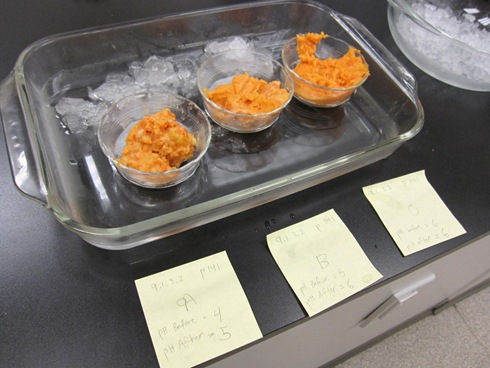
“Test the fat of cheese”
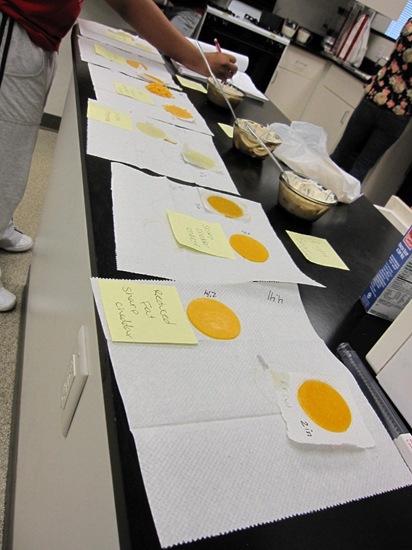
Add some acid to all kinds of liquid dairy
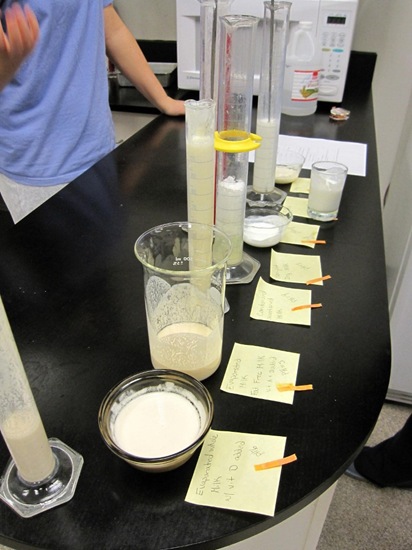
Onion cream cheese dip (compare the fat levels). Ewww. I didn’t do a sensory analysis on these.
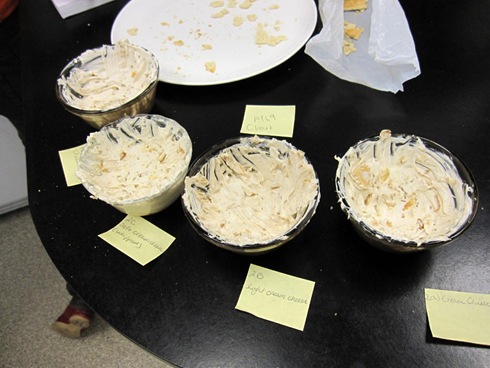
Milk tasting. Options: whole, 2%, skim, soy, goat’s (liked it!), butter, condensed whole, condensed fat free, condensed sweetened (my fav!), kefir, lactaid (which I liked!)
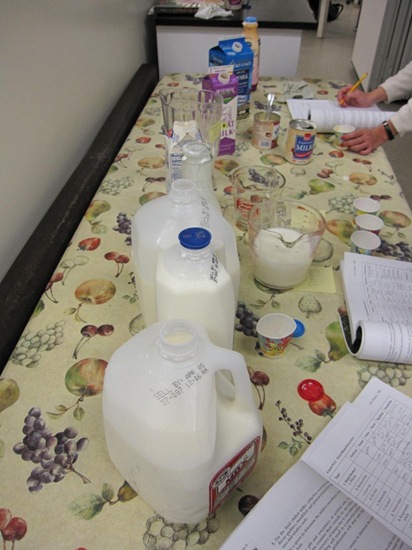
Add acid + bake with ham
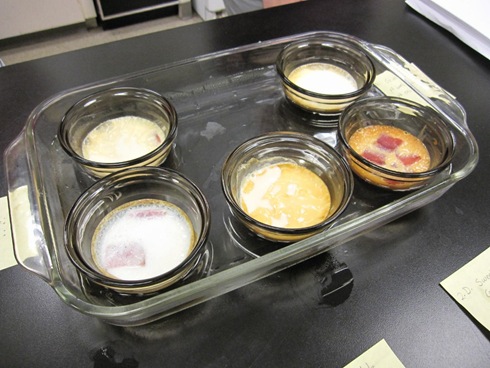
Throughout the lab I had a few tiny milk samples and a saltine 🙂
I came home pretty hungry and knew exactly what I wanted: a Spinach Salad + A Cinnamon Raisin Bun.
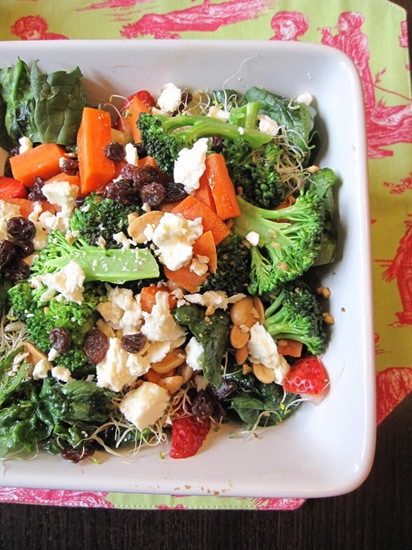
This salad rocked
Ingredients:
- Whole leaf spinach, torn, tossed in EVOO + Fig balsamic vinegar
- Broccoli
- Carrot
- Cuc
- Strawberry
- Sprouts
- Raisins
- Feta
- Peanuts
- Drizzle honey
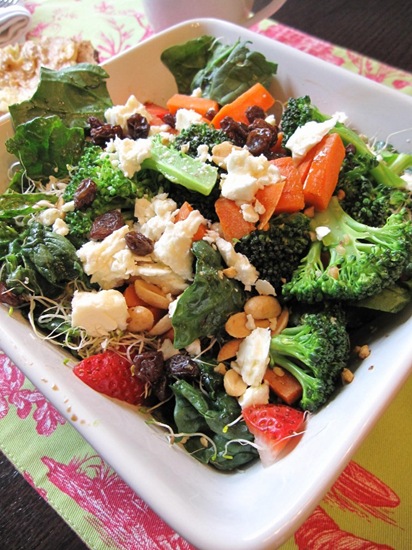
Cinnabun with mashed banana + Naturally more – had to get my PB fix today!
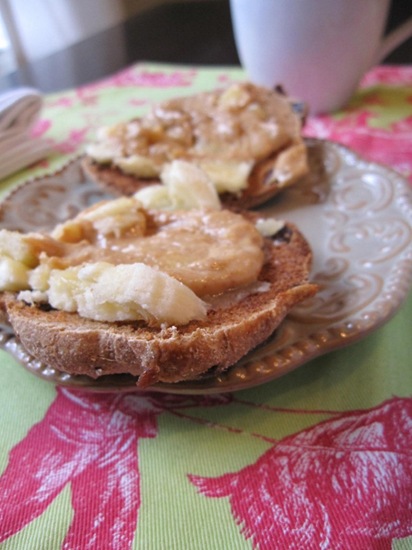
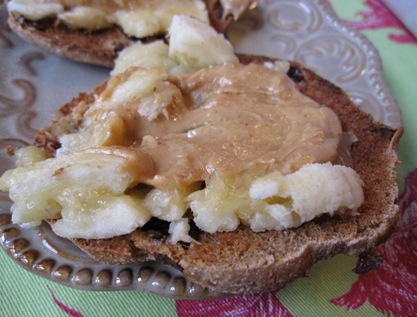
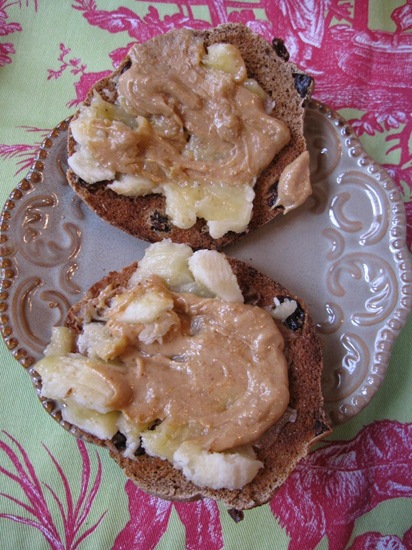
With green tea (This just in from the Lipton Institute: There is no scientific evidence that the addition of milk affects the L-Theanine or antioxidant properties of tea. My guess is that the studies done have shown there may be a link between milk and antiox absorption, but it is not proven.)
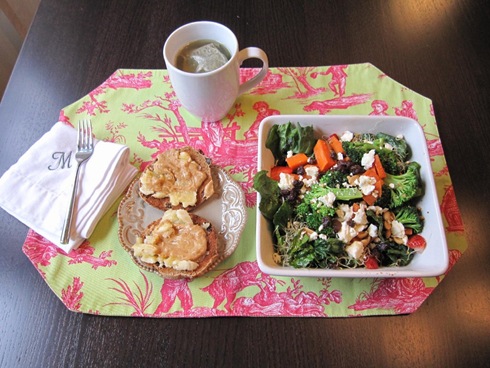
For dessert I went to town on the empty Naturally More jar with a knife.
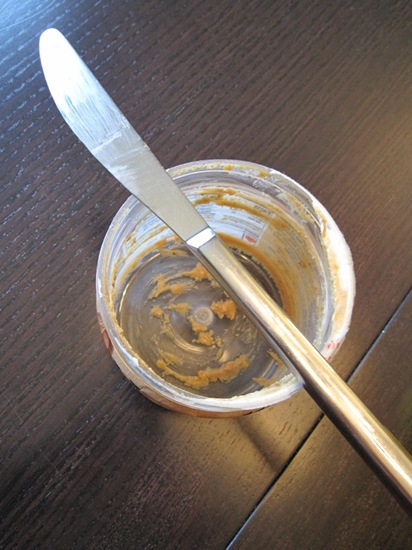
Tea Time
Here’s Kelly’s recent post on cooking in Kenya! Tea Time: Efficient Cooking in Rural Kenya
I’m off to cram for Biochem and hopefully knock out a paper introduction. Maybe some fun music will sweeten the chore


zestycook says
That salad and bread looks awesome! I mean awesome. Have a good time studying!
zest!
tina says
That does look like a good salad!
Marissa says
Yay broc!
jackie says
Hi,
What is the purpose in testing all these foods and dairy? The food lab class sounds really interesting. I’m curious about the results after you tested the fat in cheese. Have a great weekend.
VeggieGirl says
Boo to the rain 🙁 But hooray for the eats!! 🙂
I definitely thought that the post title said, “Dreary Diary” at first, haha.
Courtney (The Hungry Yogini) says
Cool lab and gorgeous lunch. Glad you got your PB fix. A day without PB is like a day without air…not possible!
BethT says
Do you like food lab? It always looks so fun and interesting!
Katie Wahl says
Kelly’s post was great! After seeing pictures that you and others took that seem to include cats or dogs, I was wondering did you see a lot of strays? I do some animal rescue and it always breaks my heart to see stray animals when I am traveling and in one of Kelly’s pics there is a very skinny looking little dog:(
Sharon says
Hahaha, love the dessert!!
K says
That salad is stunning! Seriously, I need to recreate that one!
rhodeygirl says
Please send me one of those fabulous looking buns.
Thanks.
Tyler (Raspberry Runner) says
oooh lovely salad!
i had to do a lab similar to that last year…i’m surprised you like that goat milk! we were all gagging…it was so bitter! and straight buttermilk…ewww
Michelle Hisae says
Yummmm that salad looks so great. I love smorgasbord salads! 🙂
Katherine says
From what I have read and learned the theory that milk products may inhibit antioxidant absorption may come from those dairy products that “milk ingredients” aka “milk powder” is added to. As far as I know milk products do not inhibit antioxidant absorption, but that if we are consuming low-fat dairy products with milk powder added to them we may need an increased amount of antioxidants.
The theory is that milk ingredients or milk powder contain oxidants due to the processing that the milk undergoes. When the fats etc. are damaged by heating cream/milk they become rancid and therefore act as oxidants in the body. This also the theory for pasteurization of milk. The heat damages the fats in the milk. So perhaps it is the case that we need more antioxidants to combat this.
However – if, like Kath, we are consuming a whole (REAL) foods diet we are likely taking in enough antioxidants to combat the oxidants we consume.
Chelsea says
Yo Yo blog writer!
Mara @ What's For Dinner? says
When I worked at Starbucks, we used to bring in our own Lactaid milk to make lattes because it frothed so well. Great salad 🙂
Kara says
Your food lab stuff is always so fascinating!!
Jessica says
Hey Kath –
Have you seen these videos? http://www.youtube.com/user/DepressionCooking
Some of the recipes are not the most healthy, but there are a few – like peppers and eggs – that seem okay. I love this lady, haha. I’m wondering if I can find some ways to make these a little healthier without paying too much more?
also that salad looks YUM. I’m gonna make it today :]
Moran says
The bun looks great!!
Beadie @ What I Ate Yesterday says
I have been tempted to try goats milk but never have. And heck yes for sweetened condensed milk. I used to eat it with frosted flakes. The thought of that makes me want to barf now but I enjoyed it back then!
Sara says
on the topic of tea: do you know if there is any truth to the idea that green tea raises your metabolism? sounds like a hoax to me, but i was wondering if you learned anything about that in your tea seminars…
Julie says
That salad looks awesome, but I think the bun/pb/bana combo is better…used to make pb and banana sandwiches on cinnamon raisin english muffins for breakfast before you got me hooked on oats.
Goat milk sounds different. I like goat cheese, but…
What does it taste like?
WEEKLY BITE says
That salad does look great!
Good luck studying!
Hallie says
We use Lactaid too. Keeps fresh longer. I don’t drink milk plain so I don’t really know the difference, but I use it in oats, coffee, cooking, etc. I think it’s more expensive than milk, but if it doesn’t go bad before you use it all then it’s worth it, right?
sue says
sweetened condensed milk…YUM! good luck with the studies!
Natalie says
I’m so jealous…your experiments look SO fun!
The cinnabon with banana & pb looks so good…I’m getting hungry 🙂
JENNA says
Your salad looks so fresh and good. I’m not a big dairy fan- i hope you didnt’ have to try all your experiments 🙂
sarah (ghost world) says
mmm, MILK! your post reminded me of a common pediatric board question:
“a baby comes in for his 8 month check up. his parents have been feeding him exclusively goats milk because they are worried about cow’s milk allergy. what is this patient at risk for?
the answer is anemia — specifically megaloblastic anemia, from folate deficiency. i bet you guys might have mentioned that in your class 🙂
Shannon (The Daily Balance) says
I love it when you share your labs — so cool!
NATURALLY MORE PB and banana = best.thing.ever
delish looking salad, too! 😉
Missy (Missy Maintains) says
Love the salad! So jealous of all your food classes!
EatingRD says
I call that a peanut butter party! woo-hoo 🙂 I love scooping the last of the peanut butter out of the jar, yum!
-kristen
The Duo Dishes says
Good thing looking at the fat in cheese doesn’t turn us off from eating it. 🙂 That salad with the feta would do us some good right now.
Jennifer says
Beadie, your post reminded me of foods I used to scarf down too and now can’t imagine eating. Like all the marshmallows out of Lucky Charms cereal. Or packets of Ring Dings.
Michelle says
holy moly!!! Do you ever eat anything NOT good looking?? I’m practically drooling looking at that salad and the mushed banana on toast…how embarassing!!
Hehehe saltines seem to be a recurring theme in the labs! Maybe you could bring in some oats to switch it up a little. hehehehe 🙂
Chgoest says
Kath, I Luuuuv your blog but you’ve got to stop dissing the onions. :~D Most of us feel they taste pretty great and really add layers of flavor to a meal. It’s okay not to like a food but to say “eew” ? Also, to quote from “Onions Are Beneficial for Your Health” by Dr. Winston Craig, onions help in a number of ways to keep the body healthy :
“The Value of Onions
Onions have a variety of medicinal effects. Early American settlers used wild onions to treat colds, coughs, and asthma, and to repel insects. In Chinese medicine, onions have been used to treat angina, coughs, bacterial infections, and breathing problems.
The World Health Organization (WHO) supports the use of onions for the treatment of poor appetite and to prevent atherosclerosis. In addition, onion extracts are recognized by WHO for providing relief in the treatment of coughs and colds, asthma and bronchitis. Onions are known to decrease bronchial spasms. An onion extract was found to decrease allergy-induced bronchial constriction in asthma patients.
Onions are a very rich source of fructo-oligosaccharides. These oligomers stimulate the growth of healthy bifidobacteria and suppress the growth of potentially harmful bacteria in the colon. In addition, they can reduce the risk of tumors developing in the colon.
Cardiovascular Help
Onions contain a number of sulfides similar to those found in garlic which may lower blood lipids and blood pressure. In India, communities that never consumed onions or garlic had blood cholesterol and triglyceride levels substantially higher, and blood clotting times shorter, than the communities that ate liberal amounts of garlic and onions. Onions are a rich source of flavonoids, substances known to provide protection against cardiovascular disease. Onions are also natural anticlotting agents since they possess substances with fibrinolytic activity and can suppress platelet-clumping. The anticlotting effect of onions closely correlates with their sulfur content.
Cancer Prevention
Onion extracts, rich in a variety of sulfides, provide some protection against tumor growth. In central Georgia where Vidalia onions are grown, mortality rates from stomach cancer are about one-half the average level for the United States. Studies in Greece have shown a high consumption of onions, garlic and other allium herbs to be protective against stomach cancer.
Chinese with the highest intake of onions, garlic, and other Allium vegetables have a risk of stomach cancer 40 percent less than those with the lowest intake. Elderly Dutch men and women with the highest onion consumption (at least one-half onion/day) had one-half the level of stomach cancer compared with those consuming no onions at all. “
Michele says
I had a spinach salad today, too! Spinach is my favorite veggie!! I also had peanut butter–mine was with carrots and celery, though. 🙂
Looks like you’ve had another fun and healthy day!!
*smiles*
Michele
Sarah (lovINmytummy) says
This may be the first time one of your posts has ever NOT made me hungry 😉 Cheese fat…ewww….
Heather says
What an interesting lab! It must have been fun to get to try all those different kinds of milk. I can’t say I’ve ever tried goat’s milk. How was it different from normal milk?
What a yummy looking salad! And a great side too… nut butters and bananas were made for each other 😉
britt says
Hi Kath, I have a question
I heard that microwaving food puts harmful things in it and is bad for our bodies…have you heard anything about the dangers of microwaves? What method of cooking do you use to most and which is most healthy?
THanks!
Kath says
jackie ,
Just to learn about the composition of foods, cooking with them, being familiar with the different kinds out there.
BethT ,
It’s not the worst lab I’ve ever been in. But it’s lab. On Fridays. With reports.
Katie Wahl,
We didn’t see that many strays, but there were a few dogs at the smallholder house we visited. They seemed like they were pets though. Stray animals is heartbreaking 🙁
Katherine ,
Thanks for the info!
Jessica ,
Checking it out…
Sara ,
I don’t know the specifics of green tea ECGC (maybe I’m coming to that in my tea brochures with info from Lipton?) but I imagine it is based on some evidence. But my understanding is you’d have to drink a looooot of tea to have a noticeable effect.
Julie + Heather ,
It tasted like goat cheese!! In liquid. Milky with a slight tang.
sarah (ghost world),
You are so smart 🙂
Chgoest ,
Health benefits are not worth 24 hours of bad breath to me.
britt ,
Microwaves cook by using …microwave…to create vibrations in the particles which create heat. There are no harmful things put in because the waves go through the food and back out. The microwave boxes are made of material that contains the waves. As far as I’m concern, there’s no harm at all.
Kath
Cheree says
Hey Kath!
I recently started reading your blog, and think it is fabulous! I am a grad student as well, doing the Dietetic Internship, and will finish in August. I had to write a paper on leptin for my Endocrinology class and recommend reading some of Dr. Barry Levin’s papers. His research is really interesting! Leptin is a pretty interesting hormone! 🙂 Good luck.
Kath says
Cheree ,
Hi! Thanks for stopping in. Lucky you for already being at the internship 🙂
I’d love to read your paper if you still have it? I’ll check out Levin though!
kath
Cheree says
Kath,
I emailed you my leptin paper. Hope it helps!
Cheree
Marianne says
That looks like a fun lab – I love me some dairy. After seeing all your posts from your food lab classes, I’m really looking forward to that class once I get to it 😀